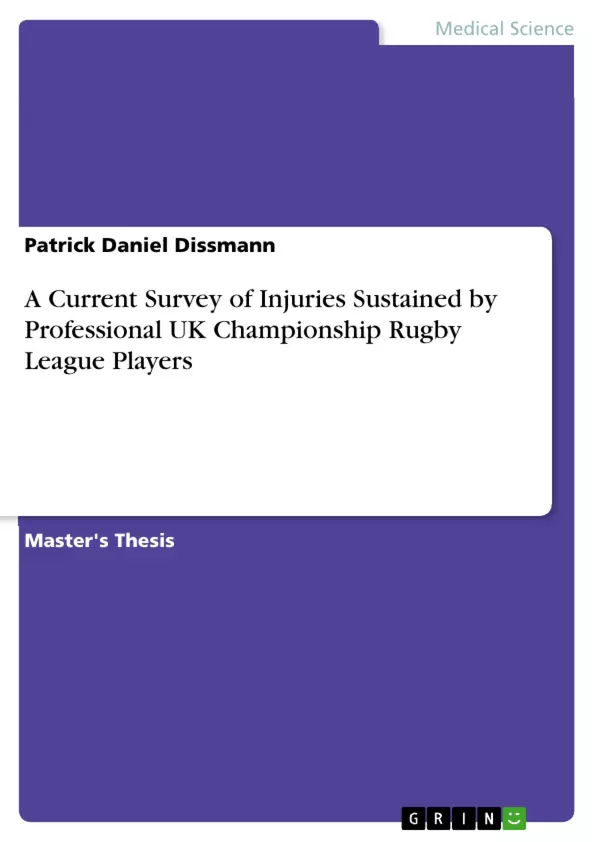Research into the incidence of injury in rugby league is very limited with a wide variation in injury rates for the same game even over comparable time periods. This may be explained by differences in the methodology of these studies and the fact that virtually all UK rugby league injury surveillance studies have been conducted pre-2000, whereas studies from the southern hemisphere mostly tend to date from post-2000.
During the 2009 season, data was collected on all injuries incurred during competitive games and rugby training sessions, for a first team squad of a British Championship rugby league club. Data analysis was limited to injury incidence rates and relative sub-category frequencies for injury causation and acuity, contact versus non-contact, nature, location and severity with transient versus time-loss as well as the influence that rugby session type and main playing position may have on these.
This study was the first to trial rugby league injury data collection according to recently published IRB standards and revealed higher than usual overall and overuse training injury rates, a larger proportion of time-loss and contact injuries as well as different relative distribution of injury severities when compared to the existing literature. This may represent new injury trends in rugby league, which need to be further examined. Therefore a multi-team, multi-season rugby league injury surveillance study should be performed, ideally at Super League and Championship level.
Inhaltsverzeichnis (Table of Contents)
- ABSTRACT
- LIST OF TABLES AND FIGURES
- List of Tables
- List of Figures
- ACKNOWLEDGEMENTS
- 1. INTRODUCTION
- 1.1 Background
- 1.2 Literature Review
- 1.3 Aims and Objectives
- 2. METHODS
- 2.1 Study Design
- 2.2 Data Collection
- 2.2.1 Injury Classification
- 2.3 Data Analysis and Presentation
- 2.4 Statistical Analysis
- 2.5 Ethical Implications
- 3. RESULTS
- 3.1 Injury Summary Data
- 3.1.1 Injury Causation
- 3.1.2 Contact versus Non-contact Injuries
- 3.1.3 Injury Nature
- 3.1.3 Injury Location
- 3.1.4 Injury Severity
- 3.2 Injury Data Sub-analysis for different Session Types
- 3.2.1 Injury Causation
- 3.2.2 Contact versus Non-contact Injuries
- 3.2.3 Injury Nature
- 3.2.4 Injury Location
- 3.2.5 Injury Severity
- 3.2.6 Transient versus Time-loss Injuries
- 3.3 Injury Data for Main Playing Positions
- 3.3.1 Injury Causation
Zielsetzung und Themenschwerpunkte (Objectives and Key Themes)
This research aims to investigate the incidence of injuries sustained by professional rugby league players in the UK Championship during the 2009 season. The study aims to provide a comprehensive overview of injury characteristics, including causation, contact versus non-contact nature, location, severity, and time-loss versus transient injuries. It also explores the influence of rugby session type and main playing position on injury rates.
- Injury incidence and characteristics in professional UK Championship rugby league players
- Influence of contact versus non-contact, session type, and playing position on injury rates
- Comparison of injury data with existing literature and identification of potential trends
- Recommendations for future research and injury prevention strategies
- Application of IRB standards for injury data collection in rugby league
Zusammenfassung der Kapitel (Chapter Summaries)
The first chapter provides a background on the limited research on injury incidence in rugby league, highlighting the need for a comprehensive study. It also reviews existing literature on rugby league injuries and outlines the aims and objectives of the current research.
Chapter two details the methodology employed in the study, including the study design, data collection procedures, injury classification system, data analysis methods, and ethical considerations.
Chapter three presents the results of the injury analysis, including summary data on injury causation, contact versus non-contact nature, location, severity, and time-loss versus transient injuries. It also explores the influence of rugby session type and main playing position on injury rates.
Schlüsselwörter (Keywords)
Rugby league, injury incidence, injury characteristics, contact sport, training, playing position, injury prevention, IRB standards, professional athletes, UK Championship.
- Quote paper
- Patrick Daniel Dissmann (Author), 2010, A Current Survey of Injuries Sustained by Professional UK Championship Rugby League Players, Munich, GRIN Verlag, https://www.grin.com/document/304279



